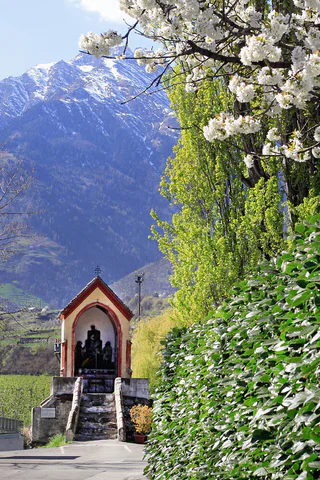
Russian Orthodox Memorial Nadezda Borodina
Merano/Meran, Meran/Merano, Meran/Merano and environs
L'arc muséal est ici très large : De l'historique au contemporain, du local à l'international, du château médiéval au fleuron de l'architecture contemporaine, du plaisir à l'irritation. Découvre les différents musées de la région.

Merano/Meran, Meran/Merano, Meran/Merano and environs

Moso in Passiria/Moos in Passeier, Moos in Passeier/Moso in Passiria, Meran/Merano and environs

1/2
Plars di Mezzo/Mitterplars, Algund/Lagundo, Meran/Merano and environs

1/5
Naturno/Naturns, Naturns/Naturno, Meran/Merano and environs

1/3
Merano/Meran, Meran/Merano, Meran/Merano and environs

1/4
Moso in Passiria/Moos in Passeier, Moos in Passeier/Moso in Passiria, Meran/Merano and environs

1/8
Parcines/Partschins, Partschins/Parcines, Meran/Merano and environs

Senale/U.L. Frau i.W., U.L.Frau i.W.-St. Felix/Senale-S.Felice, Meran/Merano and environs

1/3
Merano/Meran, Meran/Merano, Meran/Merano and environs

1/5
Foiana/Völlan, Lana, Meran/Merano and environs

Moso in Passiria/Moos in Passeier, Moos in Passeier/Moso in Passiria, Meran/Merano and environs

1/5
San Leonardo i.P./St. Leonhard i.P., St.Leonhard in Passeier/San Leonardo in Passiria, Meran/Merano and environs

1/3
Tirolo/Tirol, Tirol/Tirolo, Meran/Merano and environs

Caines/Kuens, Kuens/Caines, Meran/Merano and environs

Moso in Passiria/Moos in Passeier, Moos in Passeier/Moso in Passiria, Meran/Merano and environs

1/9
Rablà/Rabland, Partschins/Parcines, Meran/Merano and environs

1/4
Tirolo/Tirol, Tirol/Tirolo, Meran/Merano and environs

1/2
Moso in Passiria/Moos in Passeier, Moos in Passeier/Moso in Passiria, Meran/Merano and environs

1/3
Stava/Staben, Naturns/Naturno, Meran/Merano and environs

1/5
Parcines/Partschins, Partschins/Parcines, Meran/Merano and environs

Pavicolo/Pawigl, Lana, Meran/Merano and environs

1/6
Parcines/Partschins, Partschins/Parcines, Meran/Merano and environs

1/3
Santa Valburga/St. Walburg, Ulten/Ultimo, Meran/Merano and environs

1/3
Merano/Meran, Meran/Merano, Meran/Merano and environs

Merano/Meran, Meran/Merano, Meran/Merano and environs

1/5
Cermes/Tscherms, Tscherms/Cermes, Meran/Merano and environs

1/6
Moso in Passiria/Moos in Passeier, Moos in Passeier/Moso in Passiria, Meran/Merano and environs

1/3
Merano/Meran, Meran/Merano, Meran/Merano and environs

1/5
Marlengo/Marling, Marling/Marlengo, Meran/Merano and environs

Moso in Passiria/Moos in Passeier, Moos in Passeier/Moso in Passiria, Meran/Merano and environs